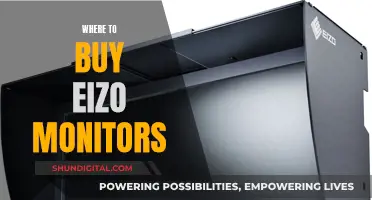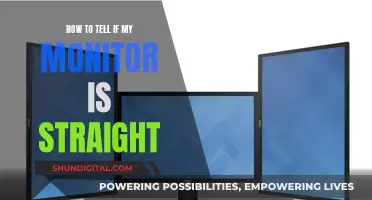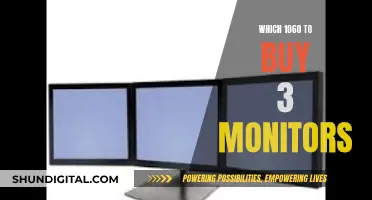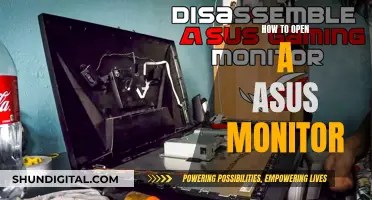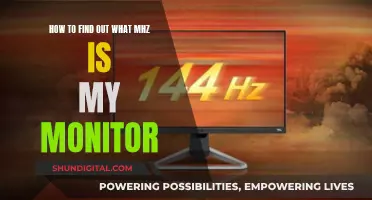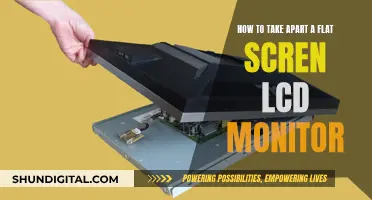
The Mazda CX-3 is a crossover SUV that comes with a host of safety features, including blind spot monitoring. The Advanced Blind Spot Monitoring system uses radar sensors to detect vehicles approaching from behind or in adjacent lanes. This feature is designed to assist drivers in checking their rear blind spots during lane changes. The system alerts drivers through a combination of warning lights and beeping sounds. While the Blind Spot Monitoring system is designed to enhance safety, it is important to note that it has certain limitations and drivers should always visually check their surroundings before making lane changes.
| Characteristics | Values |
|---|---|
| Blind Spot Monitoring (BSM) System | Uses radar sensors mounted to the rear of the vehicle to detect approaching vehicles from behind and in adjacent lanes |
| BSM Warning Indicators | Icons displayed in door mirrors; warning icon flashes in side mirror; beeping alert |
| Detection Range | Approximately 50 meters |
| Activation Conditions | Ignition is switched on; BSM switch is pressed; vehicle speed is at least 30 km/h (19 mph) |
| Non-Activation Conditions | Vehicle speed falls below 25 km/h (15 mph); vehicle is reversing |
| Limitations | May not detect vehicles travelling at the same speed for an extended period, approaching from the opposite direction, or attempting to pass |
What You'll Learn

Mazda CX-3's Advanced Blind Spot Monitoring technology
The Mazda CX-3 is a sleek and sporty crossover SUV with a full suite of advanced safety technologies, including the impressive Advanced Blind Spot Monitoring system. This technology is designed to assist drivers in checking the area behind the vehicle on both sides when changing lanes, by alerting them to the presence of approaching vehicles from the rear in adjacent lanes.
The Blind Spot Monitoring (BSM) system utilises radar sensors mounted to the rear of the vehicle, which detect vehicles approaching from behind within a range of approximately 50 meters. When a vehicle enters the blind spot zone, an icon is displayed on the appropriate door mirror, warning the driver to use caution when changing lanes. If the driver engages the turn signal while a vehicle is still in the blind spot, the system will flash a warning icon in the side mirror and emit a beeping alert.
The BSM system operates when the vehicle is travelling forward at a speed of 30 km/h (19 mph) or faster, and it will not function if the vehicle speed falls below 25 km/h (15 mph). It is important to note that while the BSM system enhances safety, drivers should always visually check their surroundings before making a lane change. Additionally, certain conditions such as snow, ice, or dirt on the sensors or rear bumper, or driving on steep slopes, may affect the system's performance.
The inclusion of Advanced Blind Spot Monitoring technology in the Mazda CX-3 showcases Mazda's commitment to safety and innovation, providing drivers with added confidence and peace of mind on the road.
LCD Monitor Battery Power: How Does It Work?
You may want to see also

Limitations of the Blind Spot Monitoring system
The Blind Spot Monitoring (BSM) system is designed to assist the driver in checking the area to the rear of the vehicle on both sides during lane changes by alerting the driver to the presence of vehicles approaching from the rear in an adjacent lane. However, it does have certain limitations:
- The system may not detect smaller vehicles like bikes and longboards.
- It will not detect non-moving objects such as guard rails, poles, and stationary vehicles.
- Not all BSM systems have parking assist and collision warning functions.
- A sensor will only detect a vehicle if it is moving at the system's suggested speed and distance.
- The system may not function properly if the sensors are covered with excessive dirt, snow, or ice.
- The system may not operate correctly in extremely hot or cold conditions, or when driving on slopes or steep inclines.
- The system may not detect vehicles in adjacent lanes on roads with very wide driving lanes.
- The system may not detect vehicles that are travelling alongside your vehicle at nearly the same speed for an extended period of time.
- The system may not detect vehicles approaching in the opposite direction.
- The system may not detect a vehicle in an adjacent lane attempting to pass your vehicle.
- The system may not function properly when pulling a trailer or when accessories such as a bicycle carrier are installed at the rear of the vehicle.
- The system may not function below a certain speed, typically around 15-19 mph.
- The system may not detect vehicles that have recently changed lanes from two lanes over.
- The system may not function correctly when turning at sharp curves or intersections, or when there is a difference in height between your driving lane and the adjacent lane.
- The system may be delayed in detecting vehicles or may not detect them at all, even when they are in an adjacent lane.
- The system may be affected by stationary objects on the road or roadside, such as guardrails, tunnels, sidewalls, and parked vehicles.
- The system may not function properly if the vehicle's mirrors or sensors are not properly adjusted or aimed.
- The system may not function correctly in certain weather conditions, such as snow or heavy rain.
- The system may not be 100% reliable and may give false alarms or fail to detect vehicles in some situations.
It is important for drivers to be aware of these limitations and not rely solely on the BSM system. It is always the driver's responsibility to check the surrounding area visually before making a lane change.
ASUS Monitor Drivers: Where Are They Stored?
You may want to see also

Working conditions of the radar sensors
Radar sensors are a key technology that is rapidly evolving. They are used for the contactless detection, tracking, and positioning of objects by means of electromagnetic waves.
Radar sensors are used in many applications, including automotive systems, and don't produce images. They form a sort of cloud of dots, which gives a rough indication of objects' contours and the infrastructure of the surroundings.
The working conditions of radar sensors are dependent on the application and the environment in which they are used. Here are some factors that affect the working conditions of radar sensors, particularly in the context of the Mazda CX-3's Blind Spot Monitoring (BSM) system:
- Speed: The BSM system in the Mazda CX-3 is designed to operate when the vehicle speed is about 30 km/h (19 mph) or faster. Below this speed, the system will not operate.
- Direction Indicator: The BSM system warns the driver of a vehicle in the blind spot zone by flashing a warning icon in the side mirror and beeping. This is activated when the direction indicator lever is operated to signal a lane change.
- Obstacles and Interference: The radar sensors may not function properly if there is an accumulation of snow, ice, or mud on the rear bumper near the sensors. Additionally, driving on snow-covered roads for long periods or in extremely hot conditions can affect the sensors' performance.
- Target Objects: The radar sensors may not detect target objects or may have difficulty detecting them under certain conditions. For example, if a vehicle is in the detection area but not approaching, or if a vehicle is travelling alongside the host vehicle at nearly the same speed for an extended period.
- Road Conditions: The BSM system's warning lights and beeps may be delayed or may not activate under certain road conditions, such as driving on steep slopes, crossing the summit of a hill, or turning at intersections.
- Bluetooth and Electronic Interference: In some cases, users have reported issues with the BSM system related to Bluetooth connectivity. Additionally, electronic interference from other devices or systems may affect the performance of the radar sensors.
- Maintenance and Calibration: Regular maintenance and calibration of the radar sensors are essential to ensure optimal performance. Misalignment or damage to the sensors can lead to inaccurate readings.
- Weather Conditions: While radar technology is generally considered to be effective in various weather conditions, heavy precipitation, fog, or snow can impact the performance of the sensors.
- Range and Distance: The detection range of the radar sensors is crucial for their effective operation. The Mazda CX-3's BSM system has an effective detection range of approximately 50 meters. Objects outside this range may not be detected.
- Objects and Materials: The composition and shape of objects in the path of the radar waves can affect their reflection and detection. Objects with a small radar cross-section (RCS) may be more difficult to detect at longer distances. Additionally, certain materials, such as metals and seawater, reflect radar signals particularly well.
- Interference from Other Radars: Interference from other radar systems or similar technologies, such as lidar, can cause accuracy problems for the radar sensors.
Overall, the working conditions of the radar sensors in the Mazda CX-3's BSM system are dependent on a combination of factors, including vehicle speed, target objects, road conditions, maintenance, and the surrounding environment. These sensors are designed to assist the driver in detecting vehicles in blind spots and enhancing overall safety.
Best Places to Buy N1MM Logger and Spectrum Monitor
You may want to see also

The Blind Spot Monitoring warning system
The Blind Spot Monitoring (BSM) system is a safety feature designed to assist drivers in checking their rear blind spots when changing lanes. The system uses radar sensors mounted on the rear of the vehicle to detect approaching vehicles from behind and in adjacent lanes. When the system detects a vehicle in the blind spot zone, it notifies the driver by displaying an icon in the appropriate door mirror, warning them to use caution when changing lanes. If the driver engages the turn signal to change lanes while a vehicle is still in the blind spot, the BSM system will flash a warning icon in the side mirror and activate a beeping alert.
The BSM system is designed to operate when the vehicle is travelling forward at a speed of 30 km/h (19 mph) or faster, and the ignition is switched on. The system has an effective detection range of approximately 50 meters, covering the driving lanes on both sides of the vehicle and extending from the rear part of the front doors to about 50 meters behind the vehicle.
It is important to note that the BSM system is not a substitute for visually checking one's surroundings before changing lanes. Due to certain limitations, the system may not always detect vehicles in adjacent lanes, especially if they are travelling at a similar speed or if the radar sensors are blocked or covered with dirt, snow, or ice. In such cases, it is the driver's responsibility to manually check the rear and surrounding areas before making a lane change.
The BSM system can be found in select Mazda models, including the CX-3, CX-5, CX-9, Mazda2, Mazda3, Mazda6, and MX-5 Miata. It has also been incorporated into products associated with Ford Motor Company and its previous brands, Lincoln and Mercury.
Monitoring Java Heap Size: A Comprehensive Guide
You may want to see also

Issues with the Blind Spot Monitoring system
The Blind Spot Monitoring (BSM) system is designed to assist the driver in checking the area to the rear of the vehicle on both sides during lane changes by alerting the driver to the presence of vehicles approaching from the rear in an adjacent lane.
- Inoperability: In some cases, the BSM system may become inoperable, with the side mirrors not lighting up and the dashboard not indicating that the system is off. This issue has been reported by several Mazda CX-3 owners, and in some cases, resetting or upgrading the BSM system has provided a temporary solution.
- Intermittent Functionality: Some users have reported that their BSM system works intermittently, with no apparent pattern to its functionality. This issue has been challenging to diagnose, as service technicians often cannot duplicate the problem.
- Inconsistent Performance with Bluetooth: A few users have noticed that their BSM system does not work when Bluetooth is enabled on their phones. Turning off Bluetooth or waiting to enable it until after starting the car has been suggested as a workaround.
- Inconsistent Performance with Trailer or Accessories: The BSM system may not function properly when a trailer or accessories, such as a bicycle carrier, are attached to the rear of the vehicle. This is due to the radar's radio waves being blocked, resulting in abnormal system operation.
- Inconsistent Warning Alerts: The BSM system relies on radar sensors to detect vehicles in adjacent lanes. However, in certain cases, the system may fail to activate warning alerts or may delay them, even when a vehicle is present in the blind spot. This can occur when a vehicle is travelling at a similar speed alongside your car, when approaching vehicles are in lanes wider than the detection area, or when driving on steep slopes or sharp curves.
- Inaccurate Detection: The BSM system may occasionally react to stationary objects such as guardrails, tunnels, sidewalls, or parked vehicles, illuminating the warning lights unnecessarily.
LCD Monitors: Simulated Wave, Real Impact?
You may want to see also
Frequently asked questions
Yes, the Mazda CX-3 includes Advanced Blind Spot Monitoring technology. This system uses radar sensors to detect vehicles approaching from behind or in adjacent lanes and alerts the driver with a warning light and a beeping sound.
The Blind Spot Monitoring (BSM) system in the Mazda CX-3 is designed to assist the driver in checking the rear of the vehicle on both sides during lane changes. It detects vehicles approaching from the rear at a speed of 30 km/h (19 mph) or faster and turns on warning lights equipped on the door mirrors. If the driver signals a lane change when there is a vehicle in the blind spot, the system flashes a warning and activates a beeping alert.
The BSM system in the Mazda CX-3 has some limitations. It may not function properly if the radar sensors are blocked or covered with dirt, snow, or ice. Additionally, it may not work as expected when driving on steep slopes, crossing the summit of a hill, or when there is a difference in height between the driving lane and the adjacent lane. It is important to visually check the surroundings before making a lane change.
If the blind spot monitoring system in the Mazda CX-3 is not working, there are a few things you can try. First, check if the working conditions have been met, such as vehicle speed and the status of the BSM switch. If the system still doesn't work, reset the BSM or take the vehicle to an authorized Mazda service center for inspection and repair.


